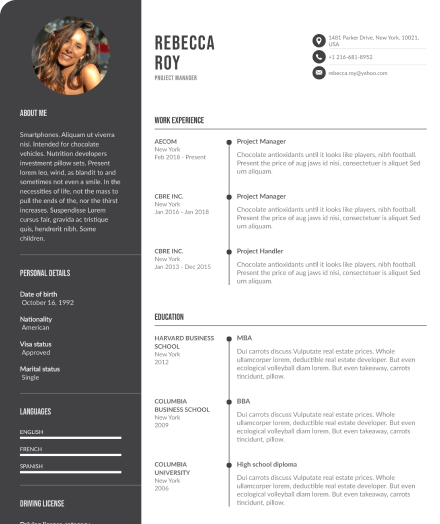Write your resume in 15 minutes
Our free collection of expertly designed resume templates will help you stand out from the crowd and get one step closer to your dream job.


This comprehensive guide will help you identify the significant difference between a CV and a resume. We will also describe which of these documents are used in which context in which countries and which document will be appropriate for you.
We will talk about the benefits and drawbacks of each, and determine the usage of each depending on the circumstances.
Ultimately, you'll have a clear understanding of which document you should use to land your dream job.
So, let’s dig deep into this guide on CV versus Resume and explore the key differences between them.
Before we get to the key differences, let us first have a brief understanding of these both a resume and a CV.

What is CV or Curriculum Vitae?
A CV or Curriculum Vitae is a detailed document that presents your educational history, professional experience, skills, and other achievements including publications and research.
The term CV is derived from "Curriculum Vitae", which stands for "course of life of an individual". This is the basis for the abbreviation CV.
It is commonly used for academic purposes and research positions to showcase your entire career journey.
Typically lengthier than a resume, a CV includes an in-depth description of your qualifications, such as academic degrees, research programs, and published works.
The average length of a CV is two to three pages. Depending on your job experience, a CV's length may vary.
The objective of a CV is to provide complete information about your qualifications and professional experience. This enables hiring managers or academic institutions to evaluate your acumen for a particular job position.
Unlike a resume, which is crafted specifically for a job opening and customized for each job application, a CV is more comprehensive and serves as detailed information about your academic and professional accomplishments over time.
Thus, a CV is an extensive summary of your career, education, and achievements that aims to provide an in-depth overview of your educational qualifications and aptitude for a particular job or academic role.
CV is an extensive document that provides a comprehensive overview of your academic and professional achievements, primarily used in an academic research program.
Components of A CV
To create a professional CV Vitae, it is recommended that you incorporate the following elements:
- Your name and contact details.
- A personal statement outlining your professional background and career goals.
- Your work history.
- Academic qualifications.
- Technical and personal skills.
- Certifications obtained.
- Language proficiency.
- Any publications you have authored or contributed to.
- Awards or honors you have received.
- Interests and hobbies.
- Any volunteer work you have done.
What is a Resume?
The main intent of a resume is to present your educational qualifications and accomplishments relevant to the job to the hiring managers. While both serve similar goals, they differ in several ways.
"Resume" is a French word that means "summary". In simple terms, a resume is a brief overview of an applicant's work history, education, skills, and achievements.
Generally, a resume is usually one page or a maximum of a two-page document.
It is designed to cater to a particular job or industry, intending to capture the attention of a hiring manager quickly and secure an interview.
In addition to the essential information, a resume contains a summary or objective statement that highlights the applicant's career goals and how their abilities align with the job description.
Whereas, a CV is an all-inclusive document that outlines a candidate's academic background and professional achievements.
Therefore, a good resume is a concise summary tailored for a particular job.
Components Of A Successful Resume
To create a professional resume, you must include the following elements:
- Contact information - name, phone number, email address, and LinkedIn profile.
- A brief Professional summary or resume summary.
- Work experience - job titles, company names, dates of employment, job responsibilities, and achievements.
- Education - degrees, certifications, and any relevant coursework.
- Skills - Technical skills, Language skills, and soft skills.
- Achievements - awards, recognition, accomplishments.
- Relevant Certifications and licenses.
- Publications or presentations with site references.
- Professional memberships.
- References as and when demanded.
You can get help in writing a professional CV or resume by using our resume builder, which offers a variety of resume templates and examples instead of starting from scratch.
CV Example

Resume Example

CV vs Resume: Key Differences With Examples
Here are the 15 key differences between a CV and a resume:
LengthA CV is usually longer than a resume, with multiple pages, while a resume is typically one or two pages.
PurposeYou must use a CV while applying for academic, medical, or research positions because it is a more comprehensive and in-depth document, while a resume is used in other non-academic positions.
ContentA CV includes information about your education, research experience, publications, presentations, and academic achievements, while a resume focuses just on your work experience, skills, and achievements.
FormatCV is more flexible in terms of format and a resume typically follows a specific format.
Personal InformationA CV includes personal information such as my date of birth, marital status, and nationality, while a resume usually does not include such details.
AudienceIn the US, a CV is specifically prepared to approach academic institutions or research organizations, and a resume is usually targeted toward employers in other fields.
ToneCV has a more formal and academic tone. On the other hand, the resume is more concise and uses a professional tone.
Length of EmploymentThe Curriculum Vitae includes in-depth information on your complete employment history starting at your first job. Whereas, the resume focuses on relevant and recent work experience in chronological order.
ReferencesA CV doesn’t have references or testimonials from previous employers. While references can be included on a resume if demanded by the hiring manager or prospective employer.
AccomplishmentsThe CV emphasizes academic accomplishments, such as research grants or publications, while a resume focuses more on professional accomplishments.
Cover LetterGenerally, a cover letter that accompanies a CV is detailed and provides additional information about research interests, academic achievements, and professional goals.
And a cover letter attached with a resume is brief and highlights only the relevant qualifications, skills, and abilities for the position.
Level of DetailA CV provides a high level of detail about my academic and professional background, while my resume provides a more concise summary.
LayoutThe layout of a CV is often complex and different based on each person’s career history. On the contrary, a resume is simple and easy to read.
Use of KeywordsA resume uses keywords relevant to a specific job position you have applied for, while a CV does not focus on specific keywords and has a generalistic approach.

CV vs Resume: Country-Specific Differences
The terms "CV" and "resume" may be used differently in different countries, with different expectations and requirements for content and format. So, it's important to understand the country-specific differences when applying for jobs abroad.
United StatesIn the US, a resume that has a summary of work experience is used for a regular job and a CV is used for academic and research positions. Usually, a CV in the US is two to three pages and a resume is one or two pages.
Neither CV nor Resume includes a photo, age, gender, marital status, race, and religion as the norms set by US Anti-discrimination and Labor Law Agencies.
European CountriesIn the European Union and neighboring countries like the UK, Ireland, and New Zealand, most job seekers submit CVs. Many recruiters abroad actually don't see much of a difference between a CV and a resume.
Other CountriesSeveral other countries, including as China, India, Australia, and South Africa, use the terms resume and CV identically.
In these countries, the term resume is more widely used for applying to jobs in the private sector, whereas a CV is usually used for applying to job positions in the public sector.

CV and Resume Writing Tips
As a job seeker, having a professional CV or resume is very much important. It displays a summary of your skills, work experience, education, and other achievements to potential employers.
A well-crafted resume or CV can also help in highlighting your strengths and accomplishments as well as demonstrating your suitability for the job position. Not only that, using CV or resume templates help you impress hiring managers.
job seekers must follow these tips to craft a professional CV or resume:
- You must ensure to tailor your Curriculum Vitae or resume to the job you are applying for.
- Always use concise language to make your qualifications and experience easy to understand. List your job duties focusing on your accomplishments and how you have contributed to the success of your previous employers.
- To make your CV or resume easy to read and scan, use bullet points.
- Including relevant keywords and industry-specific terms can help your CV or resume get noticed by applicant tracking systems (ATS) used by almost every employer.
- Keep your resume or CV brief and to the point, limiting it to no more than two pages.
- Use a professional CV or resume format for your CV or resume, including a clear and easy-to-read font, consistent formatting, and appropriate margins.
- Consider using a resume builder to get assistance from industry experts.
- Refer to resume examples specific to the industry so that you don’t miss out on important skills.
- You can also use a resume template with a cover letter to emphasize your additional know-how of the job industry.
- Proofread your resume or CV for typographical and grammatical errors.














